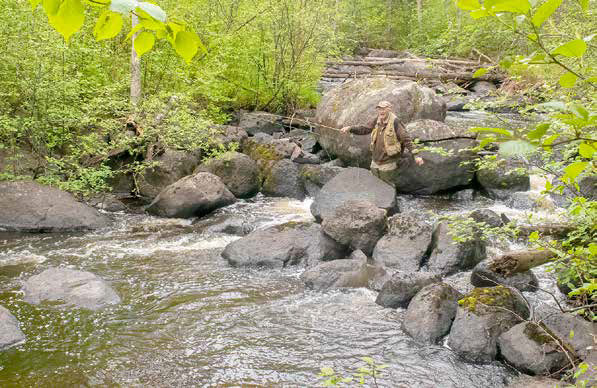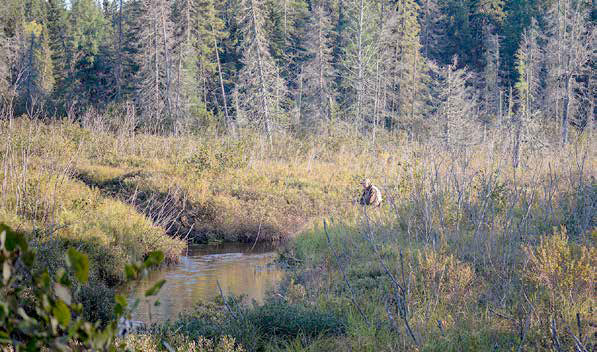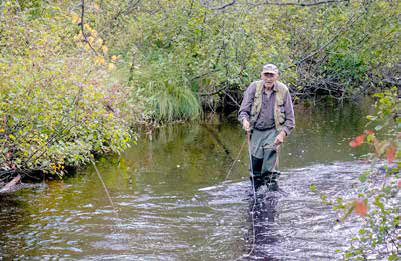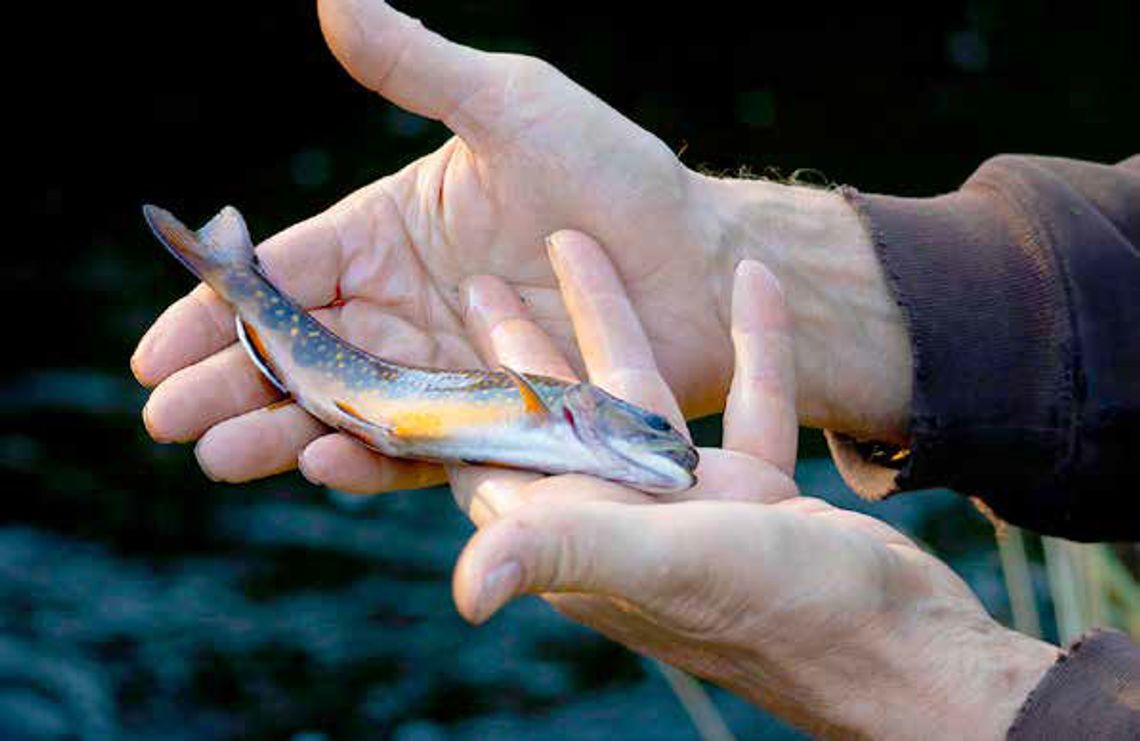Chapter 12 - Brush Bustin’ for Backwoods Brookies
“My modus operandi consisted of moving along at a leisurely pace, studying the pools carefully to determine if there was a means of approaching them in such a way that a fly could be cast into an opening, no matter how small. The problem was that the Mitawan was densely rimmed with spruce, birch, popple, willow and alder brush. It was extremely difficult to locate a casting site where the back cast would not end up snagged in the foliage, not to mention an errant forward cast in which the leader might wrap itself around an overhanging branch, the fly dangling carefree in the wind.”
Bob Cary, “Hustled on the Mitawan”
There is a romance that surrounds native wild trout in the wilderness. Visions of long canoe trips into the vast boreal forest of Canada to find native speckled trout haunt me. Fishing Lake Nipigon for a world record or laying a line in the streams flowing into Lake Superior for “coasters” have filled my imagination since I was a young man. Walleyes and northerns are fun to catch and good to eat, but the allure of the exotic has always fascinated me. Marlin in the Pacific and wild trout in the back country.
I fished for stream trout, usually rainbows, all my life in the “put and take” lakes of Moonshine and Nickle in Itasca County. It was a change of pace when I’d lay a nightcrawler on the bottom and wait for my line to trail out. It’s not the same as what I’d dreamed about. I watched DNR trucks pull up to a landing and dump thousands of fry and fingerlings into those lakes. It was a fishery to be sure, but they weren’t truly “wild” in my mind. The streams where I grew up were too warm to support native trout and any flyfishing I did was for largemouth bass and sunnies.
Imagine my excitement when moving to Ely in the late ‘70’s to hear of people fishing for native brookies! Fisherman, being as they are, were close-mouthed about where to go, so I had to find places on my own. I was disappointed. The streams listed by the local fisheries were mere brush lined trickles. It was hard to imagine that anything other than minnows could survive. I returned to wetting my line in Tofte, Miner’s, Dry Lake and High Lake.
Enter Mr. Tom Deering. As with so many other adventures that he opened me up to, conversation soon turned to wild brookies. He had pursued them his entire life. Soon, I was chasing him through the brush in the north country. Chase is a good word.
His long legs and easy gait made it difficult for me, with my feet too close to my body, to keep up.
Part of the secret to finding wild trout is covering miles of thick alders and swampy hommocks in search of water that will both hold trout and is fishable. Seldom could I see him ahead of me, so I would stop and listen as he pushed the tangle aside and splashed through liquid pools beside the streams. If he got too far ahead, I’d listen for a “Hey, Ken!” as he would try to let me know where he was.
If we were lucky, there might be an animal trail to follow. If not, our efforts were in trying to find a “neutral zone” between the upland forest and the lowland jungle that might offer an easy route. Once in a great while, we might find an old path that fishermen years before might have made.
Eventually we would dive into the thicket to make our way to the stream to scout for something we could drop a line in. The brush was like concertina wire to get through. Even worse if there were briars or thorn apples. Fallen tamarack and ash most often seemed to not make it all the way to the ground – forcing me to try to crawl over or under. Holes, rocks and hommocks could seldom be seen before they’d trip you or try to break an ankle. Straps on a backpack would reach out to grab anything it could. Carrying a fly rod was a nightmare. I soon learned to hold the butt end forward, which helped a little. The best thing was to break it down between fishing spots. Those who fish with these outfits know how much of a hassle that can be.
Most often there was little water to fish. We’d have to turn back to go out and try it again fifty yards downstream.
We would try to bring as small a backpack as we could to lessen our problems through the woods.
In it would be a fly-fishing vest (stocked with a couple of fly boxes, extra tippets, scissors, some split shot, desiccant, line dressing and a tape measure), water bottle, sandwich, apple and candy bar, along with a light rain jacket and bug dope, and in my case, a camera.
Old-timer’s wisdom says the best time to fish for brookies in the spring is when the leaves on the alder brush are the size of the nail on your pinky or the ear of a mouse. That might mean that the weather would either be cold and rainy, or hot and sunny. In either case it is right in the middle of black fly season. There is no clothing made that matches all conditions.
Eventually we would find a fishable pool. Depending on the size of the opening, we might both be able to fish there or one of us would have to struggle on. Most often we hopscotched our way down a stream. Seldom would there be room for a full back cast and front cast. At times a flip was all there was room for.
Maybe a roll cast could be used.
Often, the only option was to slip a line downstream and strip it back. The best pools would be three feet or more deep. If lucky, hip boots wouldn’t be high enough to keep from shipping water. Current was a must, and if there was a riffle leading into the hole, that would be best. Most days, I would spend more time untangling my line from a twig ten feet above me than flailing the water with my lures. When hooked, brook trout dive for the deepest part of the pool, and if around a sunken log or branch, so much the better. Catching a native brookie is no easy task!
A successful day would see us catch several small brook trout that might range between four and eight inches. One that is ten inches is considered a trophy, and a twelve incher would be a wall-hanger. Not impressed?
They are beautiful! White bellies melding to silver sides covered with red rosettes and ending with dark green on the back make a sight to behold. It can take your breath away! And – more importantly – they are wild! Spawned, hatched and grown within watersheds that have held their species for millennia. Caught in streams where you’ll never end up elbow to elbow with fellow fishermen – even on opening day. Listening to rippling water and a white-throated sparrow might be all you hear, save the wind traveling through the tops of red pines a hundred yards away. Odors embellish the freshness of spring and of the earliest of wildflowers.
Seldom do we keep a fish.
Though they taste sweet and unlike other game fish we catch later in the year, their size precludes a practical meal. Even with their staying ability in the watershed, it seems sacrilegious to remove them from their environment.
Besides the cold, clean water necessary for them to survive, a battle is ongoing to stay out of the claws and jaws of otter, mink, kingfisher and osprey. It seems as if all of nature is adamant to destroy them. They remain a symbol of a tenuous balance of nature and the fragility of making it the wild. A quick photo and back to their element. Maybe this delight will be an inch longer the next time I come through.
There are thousands of articles and videos of popular gamefish.
Walleyes, northern pike and bass, hog most attention. Wild brook trout in our Arrowhead Region almost never are mentioned unless you are familiar with works of Sigurd Olson, Shawn Perich, Rudy Senarighi or Bob Cary.
Maybe it’s best if one of the boreal forest’s most beautiful jewels is not as well-known as some of its more popular counterparts.
It’s about that time of year again. I’ll be getting some fishing gear ready to go. Tom will be in touch, and we’ll decide on a day or two to pack a lunch and visit some trout water. Will it be familiar territory? Or someplace new to explore? A limit is not what we’re after. It’s a journey to the primeval. To the home of the wild trout.






.jpg)










